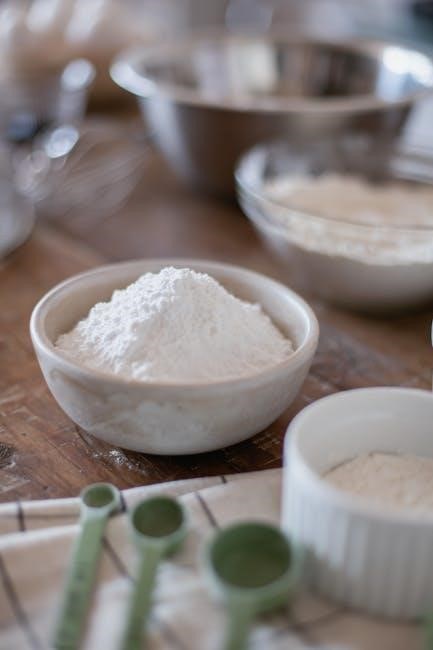“Flour Water Salt Yeast” by Ken Forkish is a comprehensive guide to artisan bread and pizza making‚ focusing on four core ingredients and their transformative power. This must-have resource offers a detailed baking education‚ catering to both novices and experienced bakers‚ with an emphasis on quality ingredients and essential techniques.
1.1 Overview of the Book
“Flour Water Salt Yeast” by Ken Forkish is a comprehensive guide to artisan bread and pizza making‚ detailing the fundamentals of working with four core ingredients: flour‚ water‚ salt‚ and yeast. The book emphasizes the importance of quality ingredients‚ essential techniques‚ and the transformative power of time in bread making. It offers a variety of recipes‚ from simple rustic loaves to more complex creations‚ catering to both beginners and serious bakers. Forkish provides clear instructions and practical advice‚ making it accessible for home bakers to achieve professional-quality results.
1.2 Author Background: Ken Forkish
Ken Forkish is a James Beard Award-winning chef and baker‚ renowned for his expertise in artisan bread and pizza. He owns Ken’s Artisan Bakery and Ken’s Artisan Pizza in Portland‚ Oregon. Forkish’s journey in baking began with a passion for traditional techniques‚ which he refined over years of practice. His book‚ “Flour Water Salt Yeast”‚ reflects his dedication to simplicity and quality‚ offering insights into the craft of bread making. Forkish’s approach emphasizes the importance of time‚ patience‚ and understanding the fundamentals of ingredients and processes.
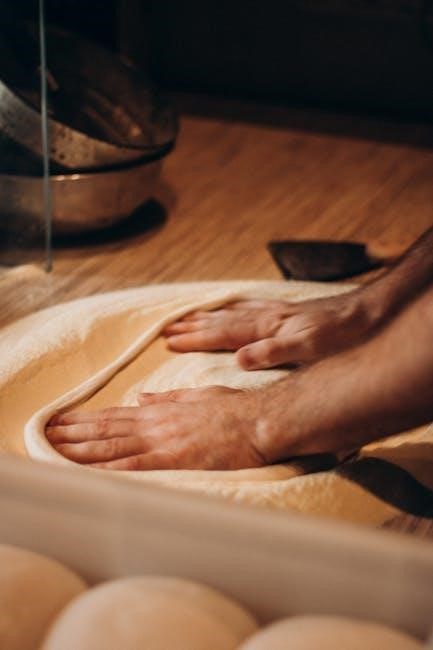
1.3 Key Themes and Objectives
The book emphasizes mastering the fundamentals of bread making through four core ingredients: flour‚ water‚ salt‚ and yeast. It aims to empower home bakers with essential techniques‚ tools‚ and schedules tailored to their skill levels and time constraints. Forkish highlights the importance of quality ingredients and their roles in creating exceptional bread. The guide also focuses on simplicity‚ offering clear‚ accessible methods for crafting artisanal bread and pizza. By breaking down complex processes into manageable steps‚ the book ensures that bakers of all levels can achieve professional-quality results in their own kitchens.
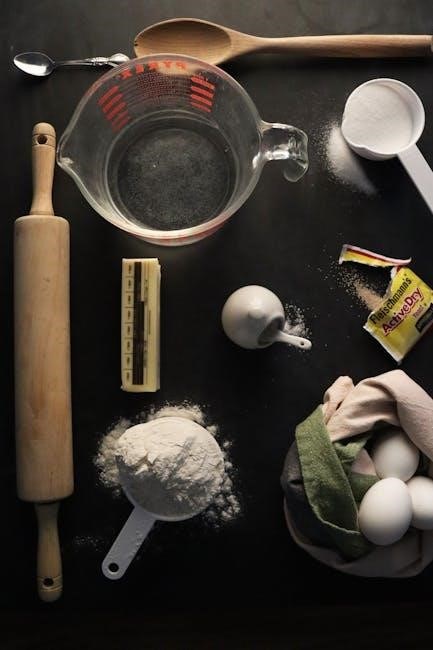
Core Ingredients in Bread Making
Flour‚ water‚ salt‚ and yeast are the cornerstone ingredients in bread making‚ each playing a vital role in texture‚ flavor‚ and fermentation. Understanding their qualities ensures success.
2.1 Flour: Types and Characteristics
Flour is the foundation of bread making‚ with various types offering distinct qualities. Bread flour‚ or strong wheat flour‚ contains 12-14% protein‚ ideal for chewy textures. All-purpose flour‚ with 9-11% protein‚ balances strength and tenderness. Whole wheat flour‚ coarser and nuttier‚ has 11-15% protein and a denser texture. The protein content determines gluten development‚ crucial for dough structure. Each type suits specific bread styles‚ from crusty loaves to delicate pastries. Understanding flour’s characteristics ensures proper dough behavior and final bread quality.
2.2 Water: Quality and Role in Dough
Water is a primary ingredient in bread making‚ essential for hydration and dough development. It creates steam during baking‚ contributing to crust formation and texture. The quality of water matters; pure water with neutral pH ensures proper yeast activity and dough balance. Hard water can strengthen gluten‚ while soft water may lead to weaker dough. Temperature is crucial—warm water activates yeast‚ while cold water slows fermentation. Proper water quantity and quality are vital for achieving the right dough consistency and texture in artisan breads.
2.3 Salt: Its Function in Bread Making
Salt is a fundamental ingredient in bread making‚ serving multiple critical roles. It enhances flavor‚ balancing sweetness from sugars and providing depth. Salt controls yeast growth‚ preventing over-fermentation and ensuring proper dough rise. It strengthens gluten structure‚ improving dough elasticity and texture. Additionally‚ salt contributes to crust development by enhancing browning and crispiness. Proper salt quantity is essential; too little may lead to bland‚ flat bread‚ while excess can inhibit yeast activity. Salt’s presence ensures a balanced‚ flavorful loaf with optimal texture and structure.
2.4 Yeast: Understanding Its Importance
Yeast is the heart of bread making‚ responsible for fermentation. It converts sugars into carbon dioxide‚ creating dough rise and light texture. Active dry‚ instant‚ and sourdough starters are common types. Yeast activity depends on factors like temperature‚ hydration‚ and pH. Proper yeast handling ensures optimal fermentation‚ contributing to bread’s flavor and structure. Ken Forkish emphasizes using quality yeast for consistent results‚ avoiding overproofing. Monitoring yeast activity is crucial for achieving the perfect balance between airiness and density in bread‚ making it indispensable in the artisan baking process.
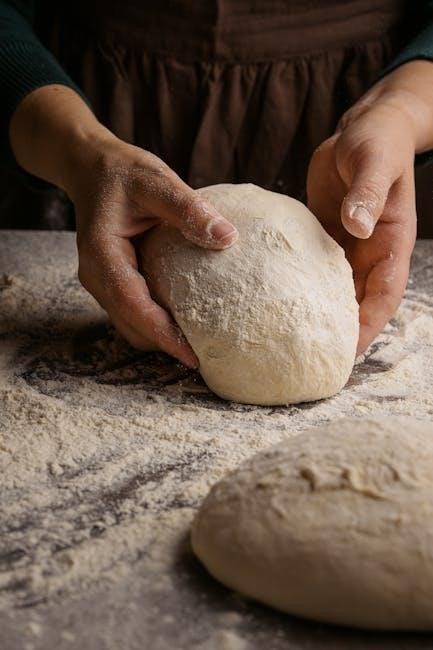
Fundamental Techniques in Artisan Bread Making
Mastering mixing‚ fermentation‚ shaping‚ and baking is essential for creating artisan bread. These steps ensure proper dough development‚ texture‚ and flavor‚ resulting in high-quality bread.
3.1 Mixing and Dough Preparation
Mixing and dough preparation are foundational steps in artisan bread making. Begin by combining warm water‚ yeast‚ and a touch of sugar to activate the yeast. Gradually incorporate flour and salt‚ mixing until a shaggy dough forms. Overmixing should be avoided to prevent dense bread. Use a stand mixer with a dough hook or mix by hand for better control. The goal is to create a cohesive dough that holds together but remains slightly rough‚ ready for fermentation and further development.
3.2 Fermentation Process: Time and Temperature
Fermentation is a critical phase where yeast converts sugars into carbon dioxide‚ giving bread its rise. Time and temperature are key factors; warmer environments accelerate fermentation‚ while cooler temperatures slow it down. Typically‚ dough ferments at room temperature (around 75°F) for 1-2 hours‚ but slower‚ longer ferments at lower temps enhance flavor complexity. Ken Forkish emphasizes monitoring dough consistency and adjusting proofing times based on ambient conditions to achieve optimal results. Proper fermentation ensures a light‚ airy texture and robust flavor in the finished loaf.
3.3 Shaping the Dough for Different Breads
Shaping dough is an art that determines the final texture and appearance of bread. Ken Forkish emphasizes techniques like rounding‚ forming oblong loaves‚ or creating batards‚ each requiring precise handling. The process involves folding and tension to develop structure‚ ensuring even baking and a crusty exterior. Proper shaping enhances airflow during proofing‚ promoting a balanced rise. Tools like a bench scraper or dough whisk aid in handling sticky dough. Forkish highlights the importance of gentle yet firm movements to preserve the dough’s integrity‚ resulting in breads with distinct character and texture‚ whether rustic or refined.
3.4 Baking Techniques and Tools
Baking is where technique and tools converge to create exceptional bread. Essential tools include a preheated Dutch oven for steam retention‚ baking stones for even heat‚ and a peel or parchment-lined sheet for easy dough transfer. High-temperature ovens enhance crust development‚ while proper ventilation ensures a dry environment. Ken Forkish advocates for long‚ slow baking to develop flavor and texture. Advanced bakers may use steam injectors or wood-fired ovens for artisanal results. The right tools and techniques transform dough into a perfectly baked loaf with a golden‚ crusty exterior and a light‚ airy interior.
Recipes for Rustic Breads
Flour Water Salt Yeast offers simple‚ rustic bread recipes like the Whole Meal Loaf and Saturday White Bread‚ emphasizing minimal ingredients and maximum flavor for bakers of all skill levels.
4.1 Simple Whole Meal Loaf Recipe
The Simple Whole Meal Loaf Recipe in Flour Water Salt Yeast combines whole meal flour‚ bread flour‚ yeast‚ salt‚ sugar‚ and warm water for a hearty‚ nutty bread. The dough mixes effortlessly‚ requiring minimal kneading‚ and ferments at room temperature. After shaping‚ it bakes to a golden crust with a chewy interior. Perfect for home bakers‚ this recipe highlights the beauty of basic ingredients and straightforward techniques‚ yielding a delicious‚ wholesome loaf ideal for sandwiches or toast. Its simplicity makes it a great introduction to artisan bread making.
4.2 No-Knead Pizza Dough Recipe
The No-Knead Pizza Dough Recipe in Flour Water Salt Yeast is a straightforward solution for homemade pizza‚ requiring just flour‚ water‚ salt‚ and yeast. The dough mixes quickly‚ rests for a short time‚ and needs no kneading. Its simplicity makes it perfect for home bakers‚ allowing for easy preparation and customization. The recipe suggests dividing the dough for multiple pizzas or even focaccia. Baked in a preheated Dutch oven‚ it achieves a crispy crust with minimal effort. This recipe highlights Forkish’s emphasis on simplicity and quality ingredients for authentic‚ artisanal results.
4.3 Saturday White Bread Recipe
The Saturday White Bread Recipe in Flour Water Salt Yeast is a classic‚ straightforward formula designed for home bakers. It uses basic ingredients—flour‚ water‚ yeast‚ salt‚ and a touch of sugar—for a soft‚ tender crumb and a golden crust. The recipe is detailed yet approachable‚ perfect for bakers of all skill levels. Forkish’s method ensures a manageable process‚ fitting seamlessly into a weekend schedule. The result is a versatile loaf ideal for sandwiches‚ toast‚ or serving alongside meals. This recipe exemplifies Forkish’s commitment to simplicity and quality‚ making it a staple in any baker’s repertoire.
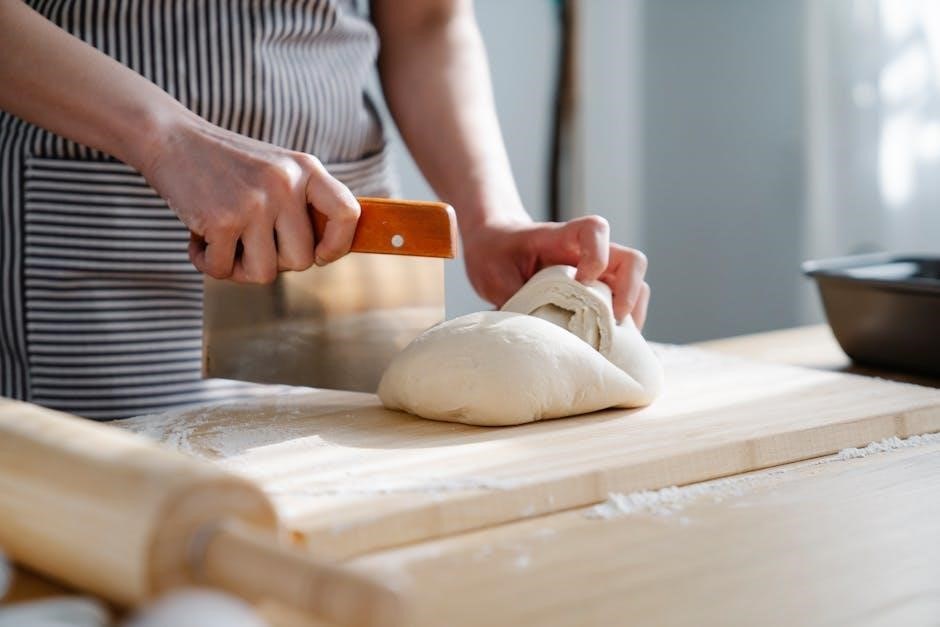
Advanced Baking Techniques
Explore expert methods like using preferments (biga‚ poolish‚ levain) and enhancing flavor with additional ingredients. Master dough hydration and texture for professional-quality breads.
5.1 Using Preferments: Biga‚ Poolish‚ and Levain
Preferments like biga‚ poolish‚ and levain are essential in advanced bread making. These natural starters enhance flavor and texture by fermenting a portion of dough before mixing the final batch. Biga is an Italian-style preferment‚ typically denser‚ while poolish is a French version‚ lighter and more liquid. Levain‚ a sourdough starter‚ offers a tangy‚ complex taste. Each method allows for longer fermentation‚ developing deeper flavors and improving dough structure. Ken Forkish details these techniques‚ providing clear instructions for incorporating them into various bread recipes‚ ensuring a more sophisticated baking experience. These steps elevate bread from simple to artisanal‚ perfect for those seeking refinement in their baking craft.
5.2 Managing Dough Hydration and Texture
Mastering dough hydration and texture is crucial for achieving professional-quality bread. The ratio of water to flour significantly impacts the dough’s elasticity and final crumb structure. Higher hydration doughs‚ often used in artisan breads‚ require precise handling to avoid overly sticky or dense results. Ken Forkish emphasizes the importance of using high-protein flours for better gluten development. Techniques like gentle folding and extended autolyse can enhance hydration without overworking the dough. Proper texture is achieved by balancing water content‚ mixing methods‚ and fermentation times‚ ensuring a tender interior and a crisp crust in every loaf.
5.3 Enhancing Flavor with Additional Ingredients
Enhancing bread’s flavor involves incorporating additional ingredients like herbs‚ spices‚ nuts‚ seeds‚ or dried fruits. These elements add complexity and depth‚ transforming basic dough into unique creations. Ken Forkish suggests experimenting with ingredients such as rosemary‚ garlic‚ or olives for savory profiles‚ while dried fruits or cinnamon create sweet variations. Proper timing is crucial; ingredients should be added during mixing or after fermentation to preserve their flavor and texture. Balancing these additions with the dough’s hydration ensures a harmonious blend of flavors without compromising the bread’s structure or rise. This technique elevates bread making to an art form.
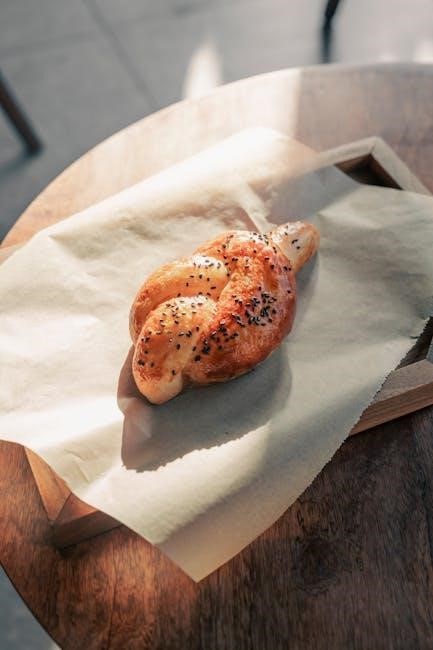
The Science Behind Bread Making
The science of bread making revolves around chemical reactions and physical transformations. Yeast fermentation‚ gluten development‚ and starch gelatinization are key processes that convert simple ingredients into bread.
6.1 Chemistry of Yeast Fermentation
Yeast fermentation is the cornerstone of bread making‚ converting sugars into carbon dioxide and alcohol. This process begins with yeast consuming sugars from dough‚ producing ethanol and CO₂. The Maillard reaction enhances flavor as amino acids and sugars interact under heat. proper temperature and pH levels optimize yeast activity‚ ensuring dough rise. Understanding this chemistry helps bakers control fermentation‚ achieving consistent results. Ken Forkish emphasizes the importance of monitoring these variables in Flour Water Salt Yeast‚ ensuring high-quality bread.
6.2 Role of Gluten in Dough Development
Gluten‚ a protein network formed from gliadin and glutenin in flour‚ is crucial for dough elasticity and structure. It traps gases during fermentation‚ enabling bread to rise and giving it chew. Proper hydration and mixing develop gluten‚ while overworking can lead to toughness. Ken Forkish emphasizes balancing gluten strength with other factors like hydration and fermentation time in Flour Water Salt Yeast‚ ensuring a tender yet durable crumb. Understanding gluten’s role is key to mastering bread texture and achieving professional-quality loaves.
6.3 Importance of pH Levels in Bread Making
pH levels play a vital role in bread making‚ affecting yeast activity and dough development. A pH range of 5.5 to 6.0 is ideal for yeast fermentation‚ ensuring proper carbon dioxide production. Ken Forkish highlights in Flour Water Salt Yeast that overly acidic dough can inhibit yeast function‚ while overly alkaline conditions may lead to poor gluten structure. Maintaining the right pH balance enhances flavor‚ texture‚ and overall bread quality‚ making it a critical factor in achieving artisanal results.
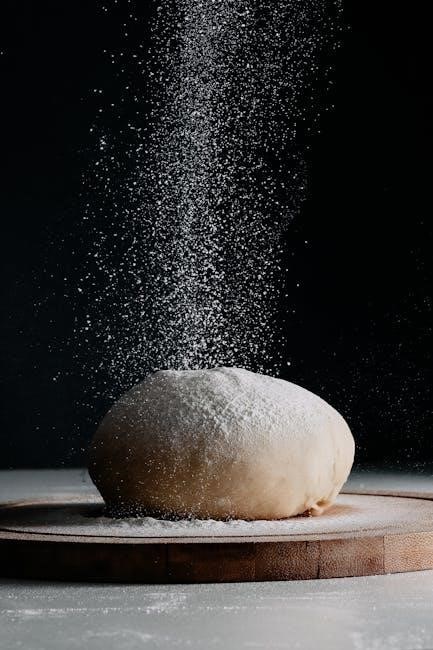
Tools and Equipment for Home Bakers
Essential tools for home bakers include mixers‚ bowls‚ measuring cups‚ baking stones‚ Dutch ovens‚ thermometers‚ and scales. These tools‚ as emphasized in Flour Water Salt Yeast‚ ensure precise measurements and optimal conditions for baking high-quality bread.
7.1 Essential Tools: Mixers‚ Bowls‚ and Measuring Cups
Mixers‚ bowls‚ and measuring cups are fundamental tools for home bakers‚ ensuring precise ingredient measurements and efficient dough preparation. Stand mixers with dough hooks simplify mixing‚ while bowls provide space for fermentation. Measuring cups guarantee accuracy‚ crucial for balancing flour‚ water‚ salt‚ and yeast. These tools‚ highlighted in Flour Water Salt Yeast‚ are indispensable for achieving consistent results in artisan bread making. Proper equipment helps maintain control over the baking process‚ from initial mixing to final shaping‚ enhancing the overall quality of the bread.
7.2 Baking Stones and Dutch Ovens
Baking stones and Dutch ovens are essential tools for achieving professional-quality bread at home. A preheated baking stone creates a crispy crust by radiating heat evenly‚ while Dutch ovens trap steam‚ mimicking artisanal ovens. Ken Forkish emphasizes these tools in Flour Water Salt Yeast‚ explaining how they enhance bread texture and flavor. Using a Dutch oven allows home bakers to produce steamy environments‚ ensuring well-risen loaves with crackling crusts. These tools are versatile and indispensable for crafting authentic artisan bread‚ making them a worthwhile investment for any serious baker.
7.3 Thermometers and Scales
Thermometers and scales are indispensable tools for precise bread making. A digital thermometer ensures accurate dough and oven temperatures‚ crucial for yeast activation and even baking. Scales provide exact measurements‚ essential for maintaining ingredient ratios. Ken Forkish emphasizes their importance in Flour Water Salt Yeast‚ highlighting how they help achieve consistency and quality. By using these tools‚ home bakers can monitor fermentation temperatures and dough hydration‚ leading to better texture and flavor. Investing in a reliable thermometer and scale elevates bread-making precision‚ making them essential additions to every baker’s arsenal.
Common Challenges and Solutions
Common challenges in bread making include yeast activation issues‚ overproofing‚ and crust texture. Solutions involve adjusting temperatures‚ monitoring proofing times‚ and ensuring proper dough hydration for consistent results.
8.1 Troubleshooting Yeast Activation Issues
Yeast activation issues often arise from improper temperature‚ poor water quality‚ or expired yeast. Ensure water is warm (not hot) and free of chlorine. Add a small amount of sugar to feed the yeast. If using active dry yeast‚ verify its expiration date and store it properly. Avoid using cold water‚ as it won’t activate yeast effectively. For instant yeast‚ no proofing is needed‚ but a warm environment still aids fermentation. Always dissolve yeast in water before adding other ingredients to confirm activity. Proper activation is key for consistent bread making success.
8.2 Fixing Overproofed or Underproofed Dough
Overproofed dough becomes bubbly‚ slack‚ and may emit a sour odor‚ while underproofed dough remains firm with little expansion. Correcting overproofed dough involves gently folding it to redistribute yeast and allowing a shorter second rise. For underproofed dough‚ extend proofing time in a warmer environment. Avoid overmixing to preserve gluten structure. Adjusting hydration and monitoring temperature can help balance the dough. Ensuring proper handling and proofing times is crucial for achieving the desired texture and rise‚ essential for successful bread making.
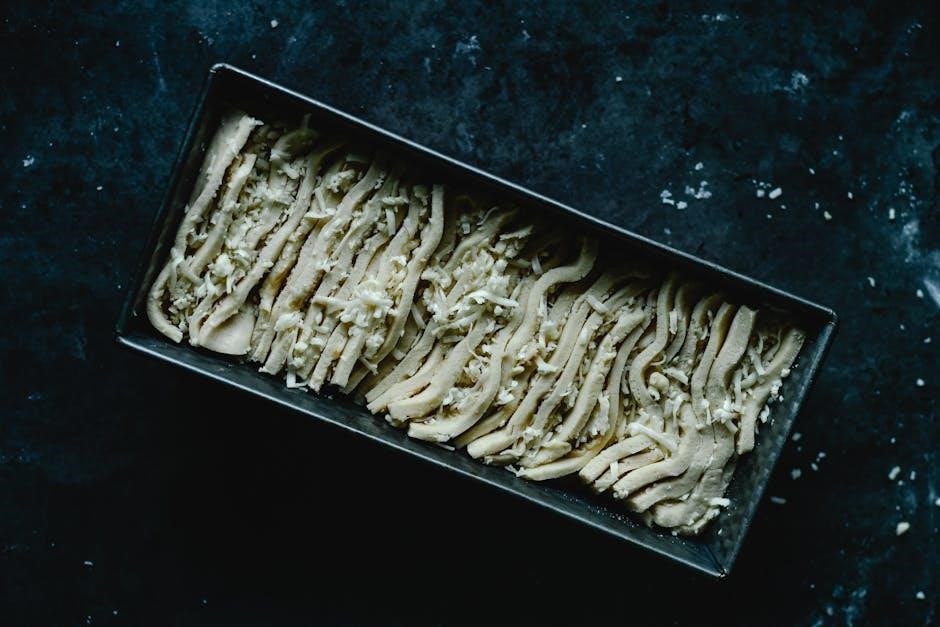
8.3 Achieving the Perfect Crust
Achieving the perfect crust requires careful attention to dough hydration‚ temperature‚ and baking techniques. High heat and steam are essential for developing a crispy‚ golden crust. Use a preheated baking stone or Dutch oven to trap steam‚ enhancing crust formation. Avoid overmixing dough to preserve its natural texture. Proper scoring allows dough to expand evenly during baking. Monitor hydration levels‚ as excess moisture can prevent crust crispiness. Adjust baking time and temperature to suit the dough’s needs‚ ensuring a well-cooked‚ flavorful crust that complements the bread’s interior. Practice and precision are key to mastering this critical step in bread making.
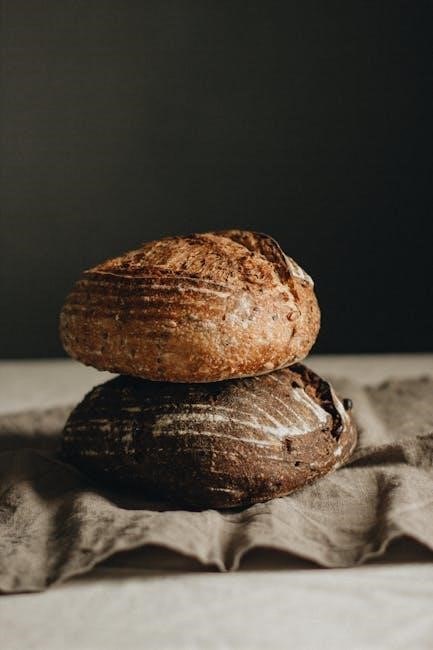
The Role of Time in Bread Making
Time is crucial in bread making‚ influencing proofing‚ resting‚ and fermentation. Proper scheduling ensures dough develops flavor and texture‚ with temperature and hydration affecting the process.
9.1 Understanding Proofing and Resting Times
Proofing and resting times are critical in bread making‚ allowing dough to develop structure and flavor. Proofing enables yeast to ferment‚ creating air pockets‚ while resting relaxes gluten‚ preventing tension. Proper timing ensures even rise and texture‚ with temperature affecting speed. Longer rests enhance complexity‚ while shorter proofing suits faster recipes. Balancing these steps is key to achieving desired bread quality and consistency.
9.2 Scheduling for Home Bakers
Scheduling is essential for home bakers to balance bread making with daily life. By breaking tasks like mixing‚ proofing‚ and baking into manageable chunks‚ bakers can adapt recipes to fit their routines. Quick doughs can be ready in a few hours‚ while longer ferments suit weekend plans. Understanding time management allows for flexibility‚ ensuring high-quality results without stress. Tools like timers and calendars help track dough development‚ making artisan bread accessible even with a busy schedule.
9.4 The Impact of Temperature on Fermentation
Temperature significantly influences yeast activity and dough development. Warmer environments accelerate fermentation‚ while cooler temperatures slow it down‚ extending proofing times. Maintaining consistent temperatures ensures predictable results. For home bakers‚ using a warm place for proofing or refrigeration for retarding dough can enhance control over fermentation. Understanding temperature’s role allows bakers to adapt recipes to their environment‚ ensuring optimal dough rise and flavor development. This balance is crucial for achieving the desired texture and crust in artisan bread making‚ as outlined in Flour Water Salt Yeast.
Innovations in Bread Making
Flour Water Salt Yeast explores modern techniques and ingredients‚ such as alternative flours and ancient grains‚ offering innovative approaches to traditional bread making for home bakers.
10.1 Modern Techniques vs. Traditional Methods
Modern bread-making techniques often blend traditional practices with innovative tools and ingredients. While traditional methods emphasize long fermentation and manual processes‚ modern approaches incorporate tools like mixers and precise temperature control. The use of preferments‚ such as biga or poolish‚ aligns with both old and new practices‚ enhancing flavor and texture. Ken Forkish’s approach in Flour Water Salt Yeast bridges these gaps‚ offering adaptable techniques for home bakers. By balancing timeless methods with contemporary insights‚ bakers can achieve high-quality results with greater efficiency and creativity‚ making artisanal bread accessible to all skill levels. This fusion ensures bread-making remains vibrant and evolving.
10.2 Experimenting with Alternative Flours
Exploring alternative flours adds diversity to bread making‚ offering unique flavors and textures. Ancient grains like Kamut or spelt‚ whole wheat‚ and even legume flours can enhance nutritional value and complexity. Ken Forkish’s approach encourages experimentation while maintaining balance in hydration and fermentation. For instance‚ whole wheat flour requires more water due to its coarser texture‚ while ancient grains may need longer fermentation times. These experiments allow bakers to create distinctive breads that cater to various preferences and dietary needs‚ keeping the craft dynamic and inclusive for modern bakers. This creative freedom ensures bread making remains both traditional and innovative.
10.3 Incorporating Ancient Grains
Incorporating ancient grains into bread making introduces depth and history to modern recipes. Grains like Kamut‚ spelt‚ and emmer offer nuttier flavors and denser textures compared to modern wheat. These grains‚ rich in nutrients‚ require adjustments in hydration and fermentation times due to their coarser structure and higher water absorption. Ken Forkish’s approach encourages blending ancient grains with modern flours to balance flavor and texture; This practice not only diversifies bread offerings but also connects bakers to centuries-old culinary traditions‚ making each loaf a testament to heritage and innovation. Ancient grains add a unique dimension to artisan bread‚ appealing to those seeking authenticity and variety.
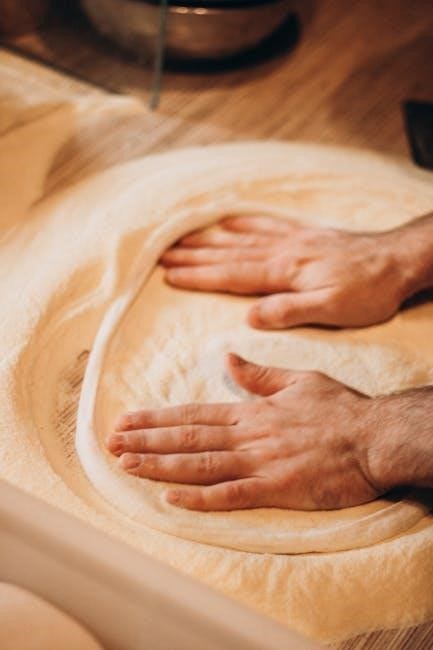
Resources and Further Reading
Recommended books‚ online forums‚ and video tutorials provide additional insights and techniques for mastering bread making. These resources support bakers in exploring advanced methods and refining their skills.
11.1 Recommended Books for Advanced Bakers
For advanced bakers seeking deeper knowledge‚ several books complement Flour Water Salt Yeast. Titles like The Bread Baker’s Apprentice by Peter Reinhart and Bread by Jeffrey Hamelman offer detailed techniques. The Cake Bible by Rose Levy Beranbaum‚ while focused on cakes‚ provides insights into precision baking. Flour & Water by Thomas Keller explores artisanal breads with a fine dining twist. These resources enrich bakers’ skills and inspire creativity in the kitchen‚ ensuring a well-rounded understanding of bread making and beyond.
11.2 Online Communities and Forums
Online platforms like The Fresh Loaf and Serious Eats offer vibrant communities for bakers to share recipes and techniques. Reddit’s r/bread and r/pizza foster collaboration‚ with members swapping tips on ingredients and methods. YouTube channels and forums dedicated to bread making provide tutorials and troubleshooting guides. These spaces allow bakers to learn from experts and enthusiasts alike‚ creating a supportive environment for refining skills. They also serve as hubs for discussing trends and innovations‚ ensuring bakers stay updated on the latest developments in artisan bread and pizza crafting.
11.3 Video Tutorials and Workshops
Video tutorials and workshops are invaluable resources for mastering bread and pizza techniques. Platforms like YouTube and specialized baking websites host tutorials by experts such as Ken Forkish‚ offering step-by-step guidance on dough preparation‚ shaping‚ and baking. Workshops often cover advanced topics like sourdough starters and artisanal methods. These visual tools help bakers understand complex processes‚ ensuring better results. They also provide interactive learning experiences‚ allowing bakers to refine their skills and explore new recipes with confidence. Such resources complement the book‚ offering hands-on instruction for home bakers of all skill levels.
